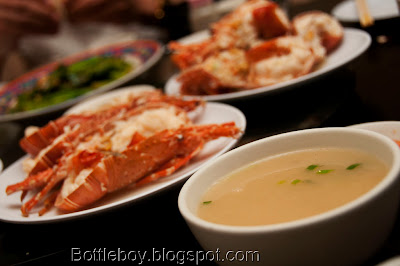Good dim sum is hard to find, more so in Malaysia. After sampling dim sum in Perth, Melbourne and Hong Kong, I had to accept the sad fact that Malaysia has no good dim sum place. During one of my previous trips back from Melbourne, I was proven wrong when friends brought me for lunch at Jin Xuan Hong Kong Dim Sum Restaurant in Damansara Jaya.
This review is actually written for my fourth visit to the restaurant. Why the delay? During my first trip this blog was not yet nascent. The subsequent three trips were made within a week. Finally, this time, I hauled my camera along. Also, I have brought a fellow eater, Kaili, with me.
 |
| 炸海鮮卷. |
This is one of the more impressive dishes that I have tried in Jin Xuan thus far. It consists of fresh, crunchy and succulent prawns, juicy scallops and golden salted egg yolks wrapped in a thin, deep fried beancurd skin. The salted egg yolks used for this dish were not too salty and did not overpower the flavour of the seafood. Problem? When this dish reaches the table, it is often cold and that is a big no-no for deep fried food.
 |
| 芋角. |
This dish is another must-eat for deep fried food lovers. Jin Xuan does this dish pretty well. The flaky bits on the crust were crispy but not soaked with oil; the layer of yam was thin enough to leave enough room for the pork filling but thick enough not to have its flavour masked by the sauce for the filling. The pork pieces could have been cut into smaller cubes though which would make the chewing process a lot more effortless and a more enjoyable experience.
 |
| 蘿蔔糕. |
I am not really Jin Xuan's fan when it comes to the fried carrot cake. It is not bad, but I have tasted better. Dragon-i does theirs much better with the crispy salted egg yolk crusted carrot cakes.
 |
| 糯米雞. |
糯米雞, is a common dish in dim sum places. Personally, I prefer the 珍珠雞, which is a variant of glutinous rice with chicken but wrapped in lotus leaf and is savoury instead of sweet. However, I have yet to find a dim sum restaurant in Malaysia that serves that, so I had to stick to the usual. Jin Xuan's glutinous rice with chicken was not too good for me. There was too much rice and too little chicken. Besides, the thick sweet sauce makes the dish too sweet for my liking.
 |
| 蝦餃. |
Prawn dumplings are the most symbolic dish in the dim sum genre. The preparation of this dish is an art kept secret, which is probably why most dim sum restaurants fail when it comes to it. Unfortunately, Jin Xuan failed to impress me with their version, despite being the best I have tasted in Malaysia so far. The skin was too thick, which in good prawn dumplings should be so thin that they are translucent, such that the prawns are clearly visible through the skin. This does not only affect the presentation but also the texture. The prawns were as crunchy as those in Perth, Melbourne and Hong Kong, but pretty bland. The thick skin also masks the flavour of the prawns with the floury taste.
 |
| 上海小籠包. |
Shanghainese dumplings, not the usual sight in dim sum shops, and for good reason. Jin Xuan's Shanghainese dumplings were disastrous. It was extremely difficult to lift the dumplings up without the juices within flowing out due to the skin of the dumplings sticking to the bamboo steamer. That alone is enough to kill the dish. If not bad enough, when I managed to lift one of the dumplings onto my spoon without bursting it, I tasted it and I was extremely disappointed. The pork filling inside tasted bad such that I do not even know how to describe it. This is a dish best left not ordered.
 |
| 燒米. |
Huge! Jin Xuan does not stinge when it comes to this dish. They serve humongous balls of pork. As much as size matters, it is not the only merit. Jin Xuan's 燒米 are tender and juicy, unlike the rubberised 燒米 in most Malaysian dim sum places. Taste wise, it is on par with the better dim sum places in Hong Kong, and that says a lot.
 |
| 蒸排骨. |
The steamed pork ribs with black bean was a big disappointment. The pork ribs did not have the porky stench, which is good. However, they tasted like green chilli. All I could taste was pork and green chilli such that it seemed like the black bean is just added for presentation.
 |
| 流沙包. |
The molten custard bun, which is my English name for it, is what brings me back to this restaurant time and time again. The core of the bun is a sticky, molten salted egg yolk which oozes out upon biting. There is nothing more enjoyable than slurping the filling and letting it warm the mouth. Mmm. This dish was perfect for me but Kaili just had to influence me by saying that the bun was a bit dry, which I noticed after her critique. Oh well.
I have a lot to complain about the dim sum in Jin Xuan but only because I compare it to all the dim sum restaurants I have dined at, be it in Malaysia, Hong Kong or Australia. However, one has to appreciate the fact that Jin Xuan is an absolute winner in Malaysia, where good dim sum is as rare as buried treasure, despite its shortcomings.
 |
| Kaili: Awesome meal. |
59, 61 & 63 Jalan SS21/19,
Damansara Jaya,
47300 Petaling Jaya,
Selangor.
View Larger Map


















































